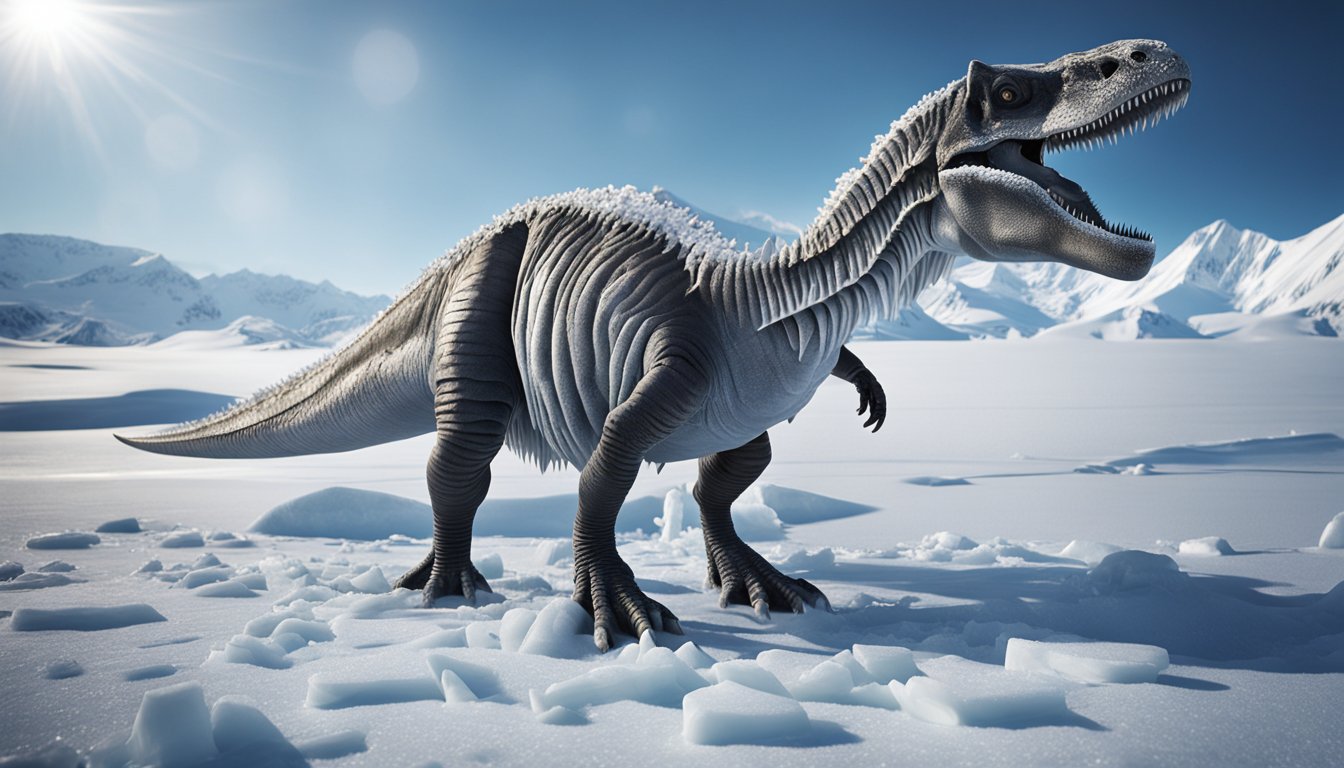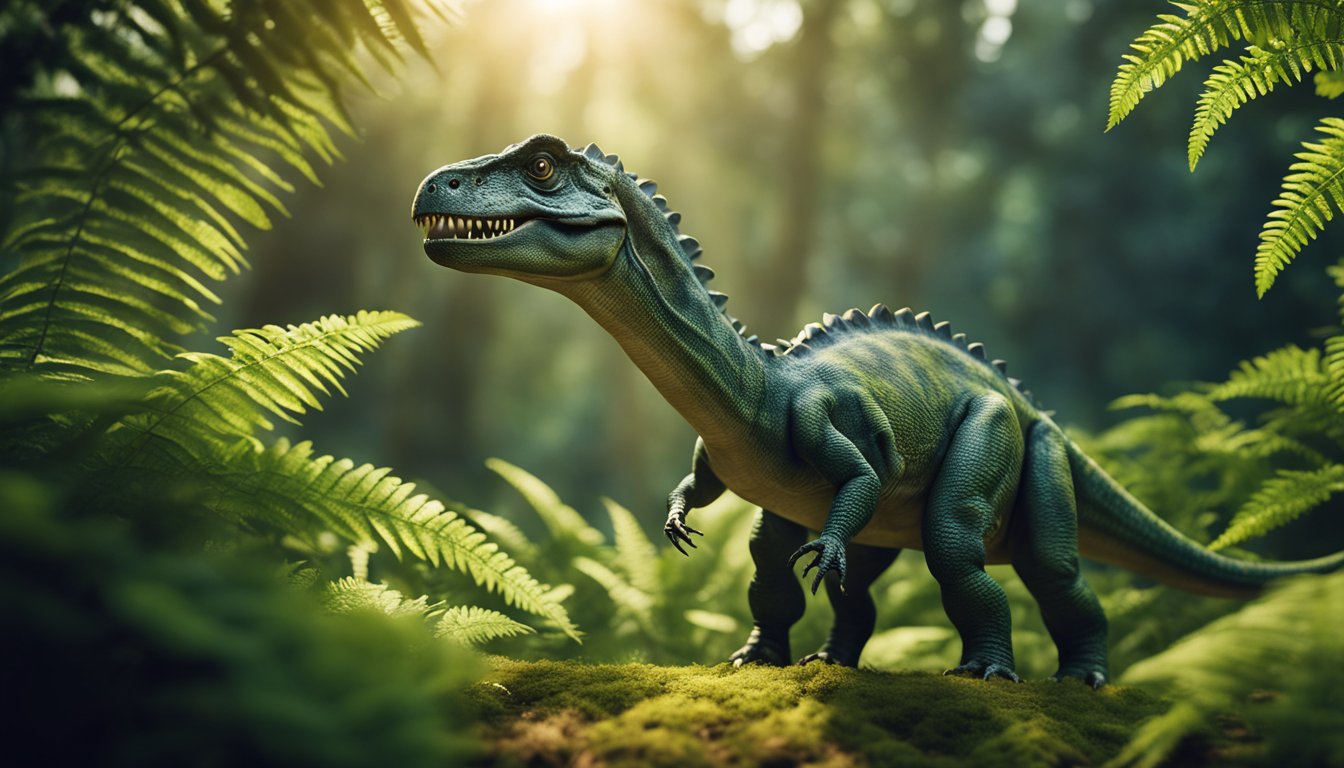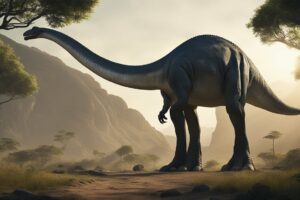Cryolophosaurus, the frozen crested dinosaur of Antarctica, is one of the most fascinating and mysterious creatures to have ever roamed the Earth.
Discovered in 1991 by a team of paleontologists from the United States, this meat-eating theropod dinosaur is unique in several ways.
Not only was it the first dinosaur ever found in Antarctica, but it also had a distinctive crest on its head that gave it a striking appearance.

Scientists believe that Cryolophosaurus lived during the Early Jurassic period, around 190 million years ago.
Despite its fierce appearance, this dinosaur was relatively small, measuring only about 25 feet in length and weighing around 1,000 pounds.
Its distinctive crest, which was made of solid bone, was thought to have been used for display purposes, possibly to attract mates or intimidate rivals.
Despite the many discoveries made about this fascinating creature, there is still much that remains unknown about Cryolophosaurus.
Scientists continue to study its fossils in order to learn more about its behavior, diet, and habitat.
As more information is uncovered, we can only imagine what other secrets this frozen crested dinosaur of Antarctica may hold.
Discovering the Ice-Age Predator
Cryolophosaurus, or the “frozen crested lizard,” is a carnivorous dinosaur that lived during the Early Jurassic period, approximately 170 million years ago.
It is one of the earliest meat-eating dinosaurs found so far, and it was discovered in Antarctica.
The First Glimpse: Unearthing Cryolophosaurus
In 1991, paleontologist William Hammer and his team from the Field Museum in Chicago discovered the first fossils of Cryolophosaurus on Mt.
Kirkpatrick in Antarctica.
The fossils were found in a rock formation known as the Hanson Formation, which is believed to date back to the Early Jurassic period.
The discovery of Cryolophosaurus was a significant breakthrough in paleontology, as it was the first dinosaur to be found on the frozen continent.
The fossils included a nearly complete skull, parts of the skeleton, and the distinctive bony crest on the dinosaur’s head, which gave it its name.
Pioneers of the Ice: Hammer and Hickerson’s Expedition
William Hammer and his team were not the first to search for dinosaurs in Antarctica.
In the late 1960s, geologist Robert Rutford led an expedition to the continent to search for fossils.
However, his team was unsuccessful in finding any dinosaur remains.
It wasn’t until the early 1990s that Hammer and his colleague David Hickerson, a geologist from Southern Illinois University, embarked on their expedition to Antarctica.
The team faced harsh weather conditions, including temperatures as low as -40 degrees Celsius and winds of up to 100 miles per hour.
Despite the challenges, they persevered and made the groundbreaking discovery of Cryolophosaurus.
The discovery of Cryolophosaurus and other dinosaurs in Antarctica has provided scientists with valuable insights into the evolution of dinosaurs and the history of the continent.
The fossils have also helped to shed light on the climate and geography of Antarctica during the Early Jurassic period.
In conclusion, the discovery of Cryolophosaurus was a significant milestone in the field of paleontology.
It was the first dinosaur to be found in Antarctica and provided scientists with valuable insights into the evolution of dinosaurs.
The expedition led by William Hammer and his team was a testament to the perseverance and dedication of paleontologists in uncovering the mysteries of the natural world.
Cryolophosaurus: The King of Ancient Gondwana

A Walk with the Dinosaurs of Gondwana
Imagine taking a stroll through the ancient land of Gondwana, over 170 million years ago.
You would have encountered some of the most fascinating creatures that ever walked the earth, including the mighty sauropods and the ferocious theropods.
Among them, a unique dinosaur stood out with a small curved crest on the top of its head.
That dinosaur was Cryolophosaurus, the king of ancient Gondwana.
The Unique Crest: A Frozen Crown
Cryolophosaurus was a theropod, a group of carnivorous dinosaurs characterized by their sharp teeth and agile bodies.
What made Cryolophosaurus special was the crest on its head. The crest was made of bone and was shaped like a fan or a Mohawk.
The crest was a unique feature among theropods and is still a mystery to scientists.
Some theories suggest that the crest was used for display purposes, while others suggest that it played a role in regulating body temperature.
Whatever the reason, the crest made Cryolophosaurus stand out from other theropods and earned it the nickname “Elvisaurus.”
The Cryolophosaurus Diet: What’s for Dinner?
Cryolophosaurus was a carnivore and would have hunted other dinosaurs for food.
Its sharp teeth and strong jaws were perfect for tearing flesh and crushing bones.
Cryolophosaurus lived in what is now Antarctica, which was once part of the supercontinent Gondwana.
The climate in Antarctica was much milder during the Jurassic period, and Cryolophosaurus would have had plenty of prey to choose from.
Some of the dinosaurs that Cryolophosaurus would have hunted include the long-necked sauropods, which were the largest animals to ever walk the earth.
Cryolophosaurus was a member of the Saurischia, a group of dinosaurs that included both theropods and sauropods.
The Saurischia were one of the two main groups of dinosaurs, the other being the Ornithischia.
The Saurischia were characterized by their lizard-like hips, while the Ornithischia had bird-like hips.
In conclusion, Cryolophosaurus was a unique and fascinating dinosaur that roamed the ancient land of Gondwana.
Its small curved crest on the top of its head made it stand out from other theropods, and its sharp teeth and strong jaws made it a formidable predator.
Cryolophosaurus lived in what is now Antarctica and would have hunted other dinosaurs for food, including the long-necked sauropods.
Living in the Land of Extremes

Antarctica, the southernmost continent on Earth, is known for its extreme climate, with temperatures that can drop below -100°F.
Yet, millions of years ago, this frozen land was home to a variety of animals, including the Cryolophosaurus, a meat-eating dinosaur that lived during the Early Jurassic period, about 170 million years ago.
Surviving the Antarctic Chill
Despite the harsh conditions, Cryolophosaurus thrived in Antarctica.
Its body was adapted to the cold climate with a thick layer of feathers that kept it warm.
The feathers also served as camouflage, helping the dinosaur blend in with the snowy landscape.
To survive the long, dark winters, Cryolophosaurus would have had to store up enough food during the summer months.
It likely hunted other animals, such as Glacialisaurus, a long-necked plant-eating dinosaur that lived alongside it.
Antarctic Neighbors: Plant-Eaters and Predators
Cryolophosaurus was not the only dinosaur living in Antarctica during the Early Jurassic.
Glacialisaurus was one of its plant-eating neighbors, while Antarctopelta, a heavily-armored dinosaur, was one of its predators.
The plant-eating dinosaurs of Antarctica had to adapt to the harsh climate by developing specialized teeth and digestive systems to extract nutrients from tough, fibrous plants.
Meanwhile, the predators had to be skilled hunters, able to take down large prey despite the difficult terrain.
Despite the challenges of living in Antarctica, Cryolophosaurus and its neighbors managed to survive for millions of years.
Today, their fossils provide valuable insights into the ancient world and the creatures that once roamed the frozen continent.
Frequently Asked Questions

How big was the Cryolophosaurus compared to other dinosaurs?
Cryolophosaurus was a large dinosaur, but it was not the biggest dinosaur that ever lived. It was about 25 feet long and weighed around 500 kilograms.
This means it was about the same size as a large elephant or a school bus.
However, compared to other meat-eating dinosaurs, Cryolophosaurus was relatively small.
What type of habitat did the Cryolophosaurus live in?
Cryolophosaurus lived in what is now Antarctica during the Early Jurassic period, around 170 million years ago.
At that time, Antarctica was not covered in ice like it is today. Instead, it was a temperate forest, with lush vegetation and a mild climate.
Cryolophosaurus likely lived in this forested environment, hunting other animals for food.
What is the significance of the Cryolophosaurus fossils found in Antarctica?
The discovery of Cryolophosaurus fossils in Antarctica was significant because it provided evidence that dinosaurs once lived on this continent.
It also helped scientists better understand how the continents have shifted over time.
Additionally, the discovery of Cryolophosaurus fossils has given scientists insights into the behavior and ecology of early meat-eating dinosaurs.
What evidence suggests whether or not Cryolophosaurus had feathers?
Although no direct evidence of feathers has been found on Cryolophosaurus fossils, scientists believe that this dinosaur likely had feathers.
This is because many other meat-eating dinosaurs from around the same time period have been found with feathers.
Additionally, Cryolophosaurus had a crest on its head, which may have been used for display purposes, much like the feathers of modern-day birds.
What did the diet of Cryolophosaurus consist of?
Cryolophosaurus was a meat-eating dinosaur, which means that it likely ate other animals.
Its sharp, pointed teeth were well-suited for tearing flesh, and its powerful legs would have allowed it to chase down its prey.
Scientists believe that Cryolophosaurus may have hunted animals like small mammals, reptiles, and other dinosaurs.
How does the Cryolophosaurus skull help scientists understand its behavior and environment?
The Cryolophosaurus skull is an important piece of evidence that helps scientists understand how this dinosaur lived.
The crest on its head may have been used for display purposes, to attract mates or intimidate rivals.
Additionally, the shape of the skull suggests that Cryolophosaurus had a strong bite force, which would have allowed it to crush bones and eat tough prey.
Overall, the Cryolophosaurus skull provides important insights into the behavior and ecology of this fascinating dinosaur.






